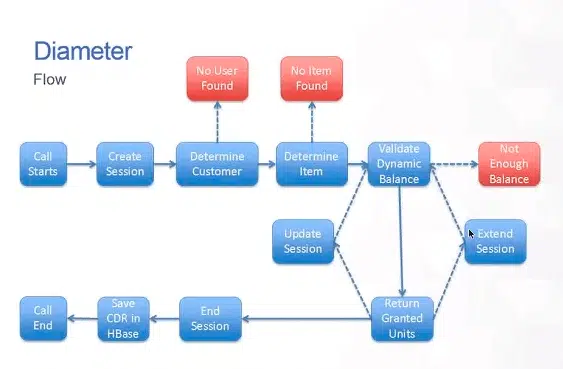- Overview
- What does an Online Charging System do?
- What is a Wallet and a top-up transaction?
- How does the Online Charging System (OCS) function?
- Which type of usages can be processed and charged by an OCS system?
- Supporting Diameter or Radius Protocol with the Online Charging System (OCS)
- Use of the latest technology and scalable architecture
- Importance of Robustness and Scalability
- Conclusion
- Resources
Overview
If your company is looking for a tried and tested Online Charging System for implementation of prepaid mobile services, look no further. Earnbill has designed and developed a reliable new Online Charging System (OCS). OCS is also referred to as Real Time Charging or Prepaid Billing system in the Telecom Billing circles. Typically, the prepaid mobile services allow for calling and mobile data usage on a SIM card. In prepaid services, the customer pays an amount equivalent to that of the plan being offered, before starting to use the services. The service cannot become functional unless there has been a prepaid payment (or a top up). The OCS system is a required system for implementing and offering prepaid services.
What does an Online Charging System do?
The Online Charging System interfaces with a network component of a Telecom Operator. This network component is a piece of equipment (hardware) and some software. In many cases, the Telecom Operators use the Universal Gateway (or a UGW offered by various providers). The UGW captures the request for usage made by the subscribers, and passes it to the Online Charging System. Typically, OCS then validates the following 3 things:
- the subscriber’s available balance,
- usage quota made available on the plan and
- the recharge expiry date.
If OCS finds that all 3 checks are passing, it responds back to the UGW (or a similar network component) confirming that the usage of the particular service can continue as there is sufficient balance or quota present for that subscriber.
The subscriber must start his or her prepaid services by buying the subscription with the Telecom operator. This is done by purchasing a new plan, the SIM and making a payment of the fees involved as a top up transaction. Many Telecom Operators also support the concept of a Wallet.
What is a Wallet and a top-up transaction?
The Wallet is nothing but a virtual account maintained by the subscriber with the Telecom Operator. The top up transaction increases the Wallet balance, whereas the allocation of a prepaid plan by the Telecom Operator to the subscriber will reduce the Wallet balance (marking that balance in use). An automatic renewal of the plan can take place at the end of the cycle (typically monthly) by deducting the available balance from the Wallet. If the balance in the Wallet is not sufficient, then the auto renewal will fail and the service will be disconnected. A new recharge will ensure that the service can start back again.
How does the Online Charging System (OCS) function?
The Online Charging System or OCS is implemented by using a software (listener component) which listens to specific requests originating from either a diameter client or a radius client. Each diameter or radius message emanating from the client (or the UGW) is picked up by the Diameter or a Radius Server implemented within the OCS. This post is written considering Radius protocol rather than Diameter, however similar concepts apply with Diameter with some differences.
The radius message could be of 4 types:
- An Access Request,
- An Accounting Start Request,
- An Accounting Intermediate Update Request, and
- An Accounting Close Request
Access Request – The UGW system creates a user session and requests for Authentication to the triple A (AAA) system in case of Diameter implementation. In case of Radius implementation, the OCS platform can provide the authentication response by verifying the authenticity of the access request.
Accounting Start Request – When the access request has been accepted by the radius server (or the OCS), then the UGW gets a confirmation that the usage can now start for the particular subscriber and service. When the usage starts, the UGW sends an Accounting Start request to the Radius server (or OCS) indicating that the usage session has been started.
The Radius server or OCS receives the Accounting Start Request and responds to it in affirmative in there is sufficient quota for the subscriber to continue with the service. There might be usage consumption minutes or bytes on the Account Start Request or not, it depends on the usage.
Accounting Intermediate Update Request – Once the Accounting Start Request is responded in the affirmative by the OCS, the next requests will be that of intermediate update. The session update requests are sent periodically by the UGW to the OCS as long as the user session (a call or a data usage session) is on. The update request will be processed by updating the usage quota or the subscriber balance.
The update requests are periodical and recurring during the course of the call or data session. For example, they may recur every minute or every 5 minutes or when the usage exceeds certain limit. In case of data session, the interim radius message could occur every 5 mins or after utilising 50 MB of data, whichever is earlier.
Accounting Close Request – An Accounting Close Request indicates that the subscriber has closed the usage session and the OCS marks session as ‘invalidated’. Then the next user session will be expected to be with another session id.
Which type of usages can be processed and charged by an OCS system?
An OCS system can charge usage for varying types of Telecom services such as the SMS, MMS, Calls, Mobile Data, Video, API calls etc. These usage types are either event based or session based. For example, the SMS and MMS don’t involve an active user session, instead they are more like events. The Calls or Mobile Data Usage on the other hand involve an active user session that can last from a few seconds to some hours.
Depending on the type of usage that needs processing, there are 2 types of implementations possible for an Online Charging System, mainly:
- Session Based Charging
- Event Based Charging
Session Based Charging
In Session Based Charging, the network hardware component (like UGW or Universal Gateway) creates a user session and keeps sending the usage in the Radius or Diameter messages. Each session starts with an authentication message followed by periodic usage update messages that carry the actual usage in minutes for calls and in bytes for data.

As shown in the above diagram, in the session based charging, the customer account balance is validated at realtime and the user session (either for call or data usage) continues if there is sufficient balance. The new usage is continuously received at periodic intervals as RADIUS messages and the balance checked at realtime. When the user session ends, the Call Data Record (CDR) or Usage Detail Record (UDR) is saved to the database in the EarnBill platform.
Event Based Charging
In the Event Based Charging, the Call Data Record (CDR) event is sent to the billing system after the event has occurred. In this case, the first message from RADIUS will be processed to check if sufficient balance exists on the customer account. The response of this message could also provide information about total units that can be consumed by the user. The final charging event could occur from the network component after the event.
The EarnBill’s OCS platform supports both session based and event based charging. The system can be easily customised to meet unique needs of Telecom companies.
Supporting Diameter or Radius Protocol with the Online Charging System (OCS)
EarnBill supports both the Diameter protocol as well as the Radius protocol while accepting messages emanating from a triple A (AAA) system (which stands for Authentication, Authorization and Accounting). EarnBill’s OCS also has the ability to replace the triple A system (AAA) by supporting the authentication and authorization, and then processing the message with the billing system to validate the usage quota.
There is a good amount of flexibility while integrating EarnBill’s OCS system into your application ecosystem. Whether the OCS system will play the role of AAA + OCS or just OCS system really depends on your existing or planned application + network infrastructure.
Use of the latest technology and scalable architecture
The real plus point of EarnBill’s Online Charging System is that it is a piece of modern software that is reliable, stable and scalable. It has been implemented using the latest technology, uses microservices architecture and a horizontally scalable set of listeners placed behind a load balancer. This would allow a telecom service provider to process millions of CDRs (Call Data Records) seamlessly over the Diameter or Radius protocol. The system has been made highly available and fault tolerant.
Up time Guarantee of the Online Charging System
The robustness and the scalability are the two most important aspects in a prepaid billing system. Imagine what would happen if the OCS system is not responding to the messages from the network. All the usage would essentially be stuck for authorisation on the network component (such as the UGW or Universal Gateway), affecting the service for thousands of telecom subscribers.
The Up time guarantee of the OCS system (or the prepaid billing system) is very important. To ensure this, the system needs to support the high availability aspect. This means that there needs to be a redundant server available to process the messages in case the primary server is unavailable due to any reasons (such as hardware or software problems).
In terms of keeping the OCS system scalable, it should be possible to add more and more subscribers to the network without compromising the response times to the network. The network component relies heavily on the billing and charging system to be able to decide if the usage of the service can continue or not.
Increase in the number of subscribers is a happy situation for the business but if it starts affecting the service for existing customers, then it could also spell bad news in quick time. In the era of 4G and 5G, it is expected that the service is not disrupted at all and the speed of usage (especially mobile data usage) is maintained at satisfactory levels despite the addition of new subscribers.
Conclusion
The Online Charging System plays a big role in today’s real time charging landscape and EarnBill’s Convergent Billing Platform is an ideal fit to implement your prepaid billing. Contact us to know more about our OCS platform.
More Blogs

How telecom billing software differentiates you? 5 Unique Ways...
How telecom billing software differentiates you? Or How to create a USP for your telecom business? You may get some interesting answers to this.
Read More…

In 2024, New and simple way to prevent revenue leakage in telecom billing
It has never been easier to prevent revenue leakage in telecom billing! Consider a BRM system that comes with RAS as a built-in feature.
Read More…

How Usage Based Billing Benefits Your Business?
Competitors offers different rates for their services, but you can’t. Customers are leaving. Let’s see How usage based billing benefits your business.
Read More…

